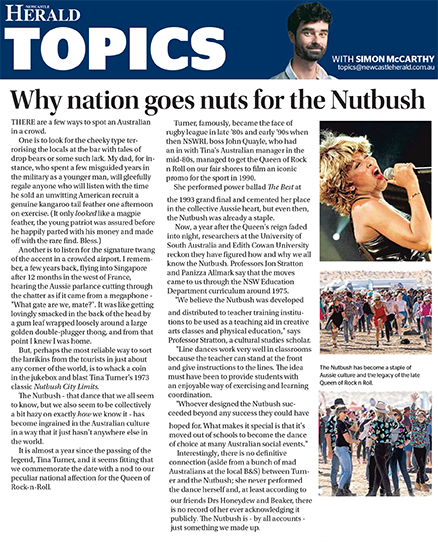Nutbush fever: How the Tina Turner hit became Australia's dance sensation
By Melissa Keogh
 CREATIVE INDUSTRIES Tina Turner, November 1972, Musikhalle Hamburg. Photo courtesy Henrich Klaffs, Flickr.
CREATIVE INDUSTRIES Tina Turner, November 1972, Musikhalle Hamburg. Photo courtesy Henrich Klaffs, Flickr.If there’s one thing Australians can’t resist doing at a wedding – it’s the Nutbush.
The iconic line dance to the 1973 R&B funk track Nutbush City Limits is an accepted part of Australian culture and has crossed generations so that children and adults break out the moves at weddings, parties and school formals.
Researchers at UniSA and Edith Cowan University in WA have explored the origins of the Nutbush and how it became an Australian cultural phenomenon.
UniSA’s Professor Jon Stratton and Edith Cowan’s Professor Panizza Allmark have researched the history of the dance to the Ike* and Tina Turner hit and say it’s likely to have originated in the halls of the NSW education department in 1975.
“We believe the Nutbush was developed and distributed to teacher training institutions to be used as a teaching aid in creative arts classes and physical education,” says Prof Stratton, a cultural studies scholar.
“Line dances work very well in classrooms because the teacher can stand at the front and give instructions to the lines. The idea must have been to provide students with an enjoyable way of exercising and learning coordination.
“Whoever designed the Nutbush succeeded beyond any success they could have hoped for. What makes it special is that it’s moved out of schools to become the dance of choice at many Australian social events.”
It’s also been claimed that the Nutbush may have come into existence from someone trying to remember the steps to the American line dance, the Madison, but ending up with an incorrect version that went on to become the Nutbush.
The daggy line dance that accompanied the semi-autobiographical song written by Tina Turner is characterised by several variations of leg movements. Despite its popularity, Turner has never performed the dance and there is no recorded comment from her about it.
The song itself is based on Turner’s small rural hometown of Nutbush in Tennessee and was released in July 1973, peaking in the music charts at number 87 in early December of that year.
Nutbush City Limits stayed off the Australian music charts throughout all of 1974, until something unusual happened. It climbed to number 27 on the Australian chart in March 1975 and stayed in the top 100 for 15 weeks. That same year the single climbed to number 8 in the NSW chart and reappeared in 1976. It also reached the heights of the Victorian and Queensland music charts.
Prof Stratton suspects its reemergence in Australian music charts was not only because the song was a “dance floor filler” but was also because of the Nutbush’s popularity and spread across Australian classrooms during that time.
“The last time Nutbush City Limits appeared in the Australian charts was when Tina Turner died at the age of 83 on 24 May 2023. The Nutbush is likely to remain an experience that Australians resonate with for some time.’’
Professor Panizza Allmark recalls dancing to the Nutbush herself in primary school in Perth around 1980 when physical education and dance classes would prepare students for highly anticipated school discos.
“Unlike formal dancing where you needed a partner, the Nutbush didn’t involve holding hands or touching anyone of the opposite sex,” she says.
“In primary school, when learning folk dancing, there was great awkwardness in having to dance with a partner of the opposite sex but with the Nutbush, you didn’t need ‘to take a partner by the hand’. You could enjoy the dance moves and be part of a communal experience without all the sweaty handholding.”
The Nutbush has become such an Australian institution that there have been various attempts to create a world record for the number of people dancing it at one time.
The record stands at 6594 dancers at the 2023 Mundi Mundi Bash in remote NSW.
*It’s now widely acknowledged that Ike Turner was a perpetrator of intimate partner abuse. Read about Tina Turner’s experiences and resilience in this Conversation article.
Other Stories
- Nutbush fever: How the Tina Turner hit became Australia's dance sensation
- Technology digs into need to send humans into mines
- End of the line for P&O: why is Australia such a tough market for the cruise ship industry?
- New Adelaide University to operate $60m defence academy
- From the Acting Vice Chancellor
- Achievements and Announcements
- Increased risk of homelessness for youth leaving out-of-home care
- UniSA helping the next generation of leaders from Papua New Guinea
- In Pictures: MOD. party and National Reconciliation Week
- The latest books from UniSA researchers





